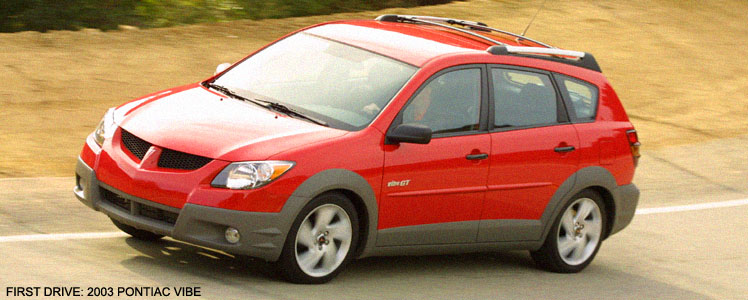
|
Before we can talk about power, we have to talk about sharing. For those who don't know, the Vibe is the sister vehicle to the Toyota Matrix. Developed in a joint venture with Toyota, the Vibe benefits from the association by virtue of the engine selection. The base Vibe comes standard with a DOHC 1.8-liter 16-valve all aluminum four-cylinder engine that sees duty in the Toyota Corolla, as well as the new Matrix. The engine produces 130 horsepower at 6,000 rpm, and 125 lb-ft of torque at 4,200 rpm. The engine features Variable Valve Timing with intelligence (VVTi), which selects the ideal intake and exhaust valve overlap as engine operating conditions vary. VVT-i eliminates the traditional compromises between low-end torque and high-rpm horsepower, as well as enhancing fuel economy and reducing emissions. The Vibe GT is Pontiac's performance model, and comes with the same 1.8-liter DOHC 16-valve all-aluminum powerplant, but receives 180 horsepower at a high-revving 7,600 rpm, and 130 lb-ft of torque at 6,800 rpm. The engine is based on Toyota's sporty Celica GT motor, and really adds a huge dose of juice to the Vibe lineup.
Features of this engine include VVTL-i, which is based on the VVT-i system. The VVTL-i system has adopted a cam changeover mechanism that varies the amount of lift of the intake and exhaust valves while the engine is operating at high speeds. In addition to achieving higher engine speeds and higher outputs, this system enables the valve timing to be optimally set, resulting in improved fuel economy. When the engine is operating in the low- to mid-speed range, the low- and medium-speed cams of the camshafts operate to move the two valves via the rocker arms. Then, when the engine is operating in the high-speed range, the signals from the sensors cause the engine's control module (ECM) to change the hydraulic passage of the oil control valve (for the variable valve lift), thus changing to the operation of the high-speed cams. Now the lift of the intake and exhaust valves increases, allowing the introduction of a greater volume of air-fuel mixture, as well as the discharge of a greater volume of exhaust gases. As a result, the engine operates at higher speeds and higher outputs when the engine is under more strain. It's a sophisticated system, and makes the Vibe more appealing because of its heritage. One last model available is the Vibe AWD, which is mated to the base 1.8-liter engine, but features a little bit less horsepower and torque than the base Vibe (123 hp/118 lb-ft of torque). The AWD model utilizes a viscous coupling setup with a torque split function designed to sense differences in wheelspin, and adjust the torque from the front wheels to the back depending on traction. The system is lightweight and compact, and is undetectable during transfer. There are three transmission choices as well, but you can't mix and match. If you opt for the base Vibe, you can choose between a four-speed automatic or a five-speed manual. If you go with the AWD version, you get the four-speed automatic. And if you opt for the GT, the only choice is the six-speed transmission (also from the Toyota Celica GT). The four-speed automatic provides smooth shifts and is transparent, the five-speed manual felt a bit sloppy, and the six-speed leaned more toward the notchy side. With the manuals, we felt like Goldilocks searching for the right porridge and bed but the "just right" isn't quite there yet. If we had to choose, though, we'd take the six speed because it comes with the GT, and we liked the GT package a lot.
While the GT and base Vibe are front-drive, both feature a MacPherson strut-type suspension with a twist beam rear. This semi-independent setup features a horizontal beam that connects the two rear wheels together. The beam can twist to help reduce the effect of one wheel's motion on the other wheel. On the AWD model, the suspension is a double wishbone setup. Both systems feature coil springs and stabilizer bars front and rear. Since
the Vibe is based on the Corolla platform, it features a 102.4-inch
wheelbase. Compared to other vehicles in this segment, such as the
Mazda Protege5 (102.8) and Focus ZX5 (103.0), it's competitive in
size, but definitely has the most track front and rear for a wider
stance, better handling, and improved road-holding abilities. To
add to the performance aspect, the Vibe features three different
wheel types: either 16-inch steel or five-spoke alloy and optional
17-inch five-spoke alloy. Rubber is either Goodyear or Continental,
and are P205/55R16 all-season or the optional Dunlop P215/50ZR17
summer tires. While the 17s fill the wheel wells a bit better, the
16s look good and deliver a good blend of highway and performance
ride.
|
|